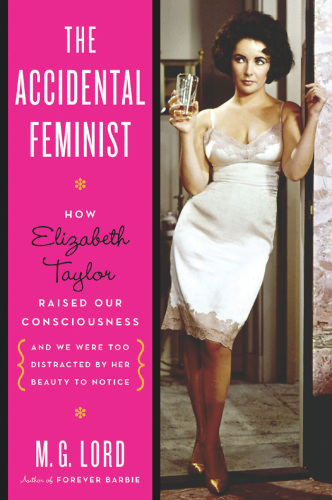
The Accidental Feminist
How Elizabeth Taylor Raised Our Consciousness and We Were Too Distracted by Her Beauty to Notice
کتاب های مرتبط
- اطلاعات
- نقد و بررسی
- دیدگاه کاربران
نقد و بررسی

October 31, 2011
Elizabeth Taylor is synonymous with “icon” both on and off the screen, but culture historian Lord’s (Forever Barbie) analysis of her film persona viewed through the lens of feminism is shaky at best. Lord alternates between rehashing biographical details of Taylor’s life—from her upbringing as a child star under strict control of her mother to her multiple marriages and lifelong friendships among the Hollywood elite—and surface-level film theory. She admits that the actress might not be synonymous with feminism in viewers’ minds, but argues that “the Taylor brand deserves credit for its under-the-radar challenge to traditional attitudes,” using films such as National Velvet (1944), A Place in the Sun (1951), Giant (1956), Butterfield 8 (1960), and Who’s Afraid of Virginia Woolf? (1966) to illustrate her point. But while Lord makes a convincing case that many of Taylor’s best-known roles do go against the grain of prescribed attitudes toward women in studio era Hollywood and beyond—for example, Taylor’s Leslie Benedict in Giant is a mouthpiece for social justice and Gloria, the call-girl she plays in Butterfield 8, is in control of her own sexuality—ascribing that feminist bent to Taylor’s onscreen persona as a whole is much murkier. Perhaps it’s Elizabeth Taylor’s status as a Hollywood legend, but Lord has bitten off more than she can chew, rather than narrowing her focus to a few films that could substantiate her point.

November 15, 2011
A chatty, name-dropping little work based on the notion that actors are, or become, the characters they portray in film and on stage. Like those who think of actor John Wayne as a real-life He-Man, Jimmy Stewart as a sort of grown-up Scout master and Humphrey Bogart as a genuine tough guy, cultural critic Lord (Masters of Professional Writing Program/Univ. of Southern California; Astro Turf: The Private Life of Rocket Science, 2005, etc.) sees a feminist in Elizabeth Taylor. The author analyzes Taylor's portrayal of characters from the spunky little girl who rode her horse to victory in National Velvet to the strident middle-aged wife in Who's Afraid of Virginia Woolf?, and in her stage performance as the fierce Regina in The Little Foxes. Into what is essentially a glowing mini-biography of the actress, Lord inserts detailed plot summaries of Taylor's films, which she admits to having watched repeatedly , along with tidbits about Taylor's several husbands and some of her fellow actors: Richard Burton, Eddie Fisher, Montgomery Clift, Rock Hudson and others. Besides finding material for her thesis in the scripts of Taylor's movies, the author interviewed people who knew her, worked with her, were related to her or wrote about her, including gossip columnist Liz Smith and Burton's daughter Kate. In Lord's view, the actress' work in the fight against AIDS in the 1980s demonstrates that roles played by Taylor as a young woman influenced her thinking about social justice as an older woman. Not central to the book but an informatory sidelight is the author's account of the Hays Code, which dictated the moral content of Hollywood films from the early '30s through most of the '60s. It forbade nudity, adultery, sexual perversion, miscegenation, drug use and irreverence to religion and the flag. How the code shaped scripts and how directors worked around the restrictions is a story worth telling. Light reading most likely to appeal to star-struck fans of People magazine.
(COPYRIGHT (2011) KIRKUS REVIEWS/NIELSEN BUSINESS MEDIA, INC. ALL RIGHTS RESERVED.)

January 1, 2012
Lord (Forever Barbie: The Unauthorized Biography of a Real Doll) combines Elizabeth Taylor's biography with a confetti of quotations on feminism and coverage of Hollywood censorship, psychology, contemporary events, and current lore. She revisits Taylor's well-known films and, with reverence, relates experiencing an impression of powerful feminism. She asserts that Taylor's motives in choosing roles were primarily idealistic and that her AIDS activism is evidence of her feminism. Lord summarizes A Place in the Sun, Giant, Suddenly Last Summer, and Who's Afraid of Virginia Woolf? and attributes to Taylor her characters' sensitivity, assertiveness, strength in victimization, or challenge to gender stereotyping. The potential for full analysis is lost as Lord dismisses the more traditional roles in The Last Time I Saw Paris, Ash Wednesday, Boom, and The Only Game in Town. Comments on BUtterfield 8 maintain the hagiographic tone that pervades the book. VERDICT The author hopes the Millennial generation will "glimpse a recent past" in Taylor's films. She provides a glimpse--quick, light, and entertaining--better for readers of Cosmopolitan than Jon Krakauer. William J. Mann's How To Be a Movie Star is a better consideration of Taylor's career.--Ann Fey, formerly with SUNY Rockland Community Coll., Suffern
Copyright 2012 Library Journal, LLC Used with permission.

























دیدگاه کاربران